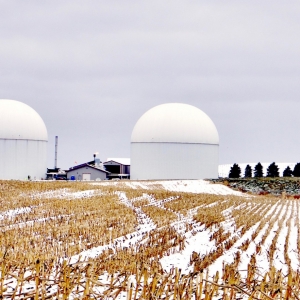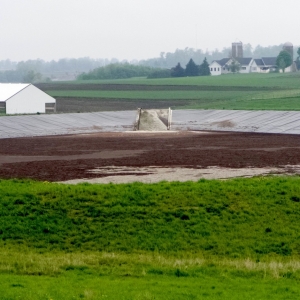The agency will evaluate the hazards from agriculture’s primary water pollutant.

Farming regions in northeastern Nebraska and elsewhere have some of the highest concentrations of nitrate in streams and groundwater due to decades of fertilizer use. Photo © J. Carl Ganter/Circle of Blue.
By Brett Walton, Circle of Blue – November 2, 2023
The U.S. Environmental Protection Agency, reversing a Trump-era decision, is restarting a human health assessment of nitrate and nitrite, a move that has potentially far-reaching regulatory implications for one of the country’s most pervasive drinking water contaminants.
The EPA suspended its nitrate assessment in December 2018. It was one of nine chemicals that the Trump administration deemed no longer a priority for evaluation by the agency’s health assessment division known as the Integrated Risk Information System, or IRIS.
That changed in June when the EPA quietly reinserted the nitrate assessment into the IRIS agenda “to address an agency priority.”
The decision to take a closer look at the chemical comes at a time of increased scrutiny and public concern over nitrate exposure and human health. Nitrate forms when nitrogen is exposed to oxygen in the air. An exponential increase in the use of synthetic, nitrogen-based fertilizers since 1950 supercharged the production of corn and soybeans. The number of large livestock feeding operations — and the amount of manure they produce — also increased rapidly.
Nutrients are essential to crop production. But the convergence of high rates of chemical fertilizer use and immense manure production led to well-documented risks to human health and the environment. In addition to generating heat-trapping greenhouse gases, over-application of nitrogen-rich fertilizer and manure contributed to steadily rising levels of nitrate in streams and groundwater, particularly in the 11 Corn Belt states across the Great Lakes and Midwest, California’s Central Valley, North Carolina, and Washington’s Yakima Valley.
The federal environmental agency’s attention to the hazards of exposure to nitrate has been historically feeble. Evidence of widespread nitrate contamination in surface waters, and in groundwater used as a source for drinking, has been documented for decades by the U.S. Geological Survey, and many state health and environmental departments. The federal environmental agency has left it up to the states to oversee nitrate contamination, which is growing steadily worse.
One of the primary sources of nitrate pollution is large livestock feeding operations, which produce some 1.4 billion tons of liquid and solid manure annually, according to the most recent accounting by the U.S. Department of Agriculture. Nitrogen-rich feces and urine, untreated, is spread across 19 million acres of farmland annually, where it drains into streams, rivers, lakes, and groundwater.
The EPA last proposed to strengthen regulations on livestock operations and waste management practices in 2008. Those rules were challenged by the American Farm Bureau Federation and other big agriculture trade associations and struck down by the federal Fifth Circuit Court of Appeals in 2011.
In 2017, and again in 2022, state and national environmental and health organizations petitioned the EPA to more carefully regulate large livestock feeding operations to limit water contamination. In August, the agency denied the petition but pledged to form a federal advisory committee next year. The advisory group will be charged to study pollution generated by large animal feeding operations, and is expected to take 12 to 18 months to conclude its work.
The risks from exposure to nitrate are real. Studies conducted in Denmark and the United States have shown nitrate in drinking water to be associated with higher rates of birth defects, pre-term birth, and low birth weight, as well as a number of cancers and thyroid disease in adults. Those associations are present at nitrate concentrations both above and, in some cases, below the federal health standard for nitrate in drinking water of 10 parts per million that was set in 1962 by the Public Health Service and later codified under the Safe Drinking Water Act in 1991.
The restarted IRIS nitrate assessment, last updated more than three decades ago, is a direct result of this accumulated evidence of harm. IRIS initially agreed to re-evaluate nitrate in 2015 at the request of EPA Region 5 and the Office of Water, which wanted updated health information to inform its periodic reviews of federal drinking water regulations. IRIS reports provide the scientific foundation for federal regulation. Nitrate and nitrite will be evaluated together because they are chemically and metabolically related.
Last year, the Office of Water, Region 5, and the Office of Children’s Health Protection re-nominated nitrate for an IRIS assessment, the agency’s press office told Circle of Blue.
Though important, don’t expect the assessment to arrive quickly, says Ila Cote, a former EPA senior science adviser in the office that oversees IRIS. Under a fast track, the process of drafting, reviewing, responding to comments, and finalizing an assessment can take four years, Cote told Circle of Blue. Controversial assessments, as the nitrate assessment will be because it affects such a powerful industry, can take longer.
“It’s so laborious you can’t hardly believe it,” she said.
IRIS is currently in the early stages of the nitrate assessment. The agency expects to release a “systematic review protocol” by the end of the year. Cote said this is an outline of methods and key studies that will be considered. The agency has not set a date for completing the assessment, which will focus on five nitrate compounds that represent main sources of exposure through drinking water and food.
A Broader Analysis
IRIS last reviewed nitrate toxicity in 1991. That assessment resulted in an “oral reference dose,” or the amount of a substance that a person can ingest without harm. The oral reference dose was based only on blue baby syndrome in infants, not on other health problems.
The updated assessment will widen the scope. It will examine both the cancer risk of nitrate and the effects on the reproductive system, metabolism, development, thyroid, and blood.

Des Moines Water Works installed a $4 million nitrate removal facility in 1992. The utility runs the equipment, at a cost of $10,000 per day, when nitrate levels spike in the Raccoon River, one of the city’s drinking water sources. Photo © Brett Walton/Circle of Blue
Cote said that new data generally results in more conservative estimates of how much of a chemical a person can be exposed to before being harmed.
In its study plan, the EPA noted challenges with conducting the assessment. Nitrate is a complex contaminant to evaluate because exposure comes not just from drinking water but from food, especially green, leafy vegetables. What’s more, the damage from nitrate is indirect. It is converted in the body to nitrite, which can then react to form harmful nitroso compounds. These conversions are affected by an individual’s diet.
Another obstacle is that relatively few nitrate studies have been published, said Leslie Stayner, a professor emeritus of epidemiology at the University of Illinois at Chicago. Researchers prefer to have a large sample from which to draw conclusions about causality.
Despite the analytical complexity, the implications of the nitrate assessment point squarely at the federal drinking water standard.
The nitrate standard was set at 10 parts per million to protect infants from suffocating due to blue baby syndrome. Exposure to high levels of nitrate in the first months of life impairs the blood’s ability to carry oxygen. The skin of ill infants, deprived of oxygen, takes on a bluish pallor. The nitrate standard protects against blue baby syndrome, but it does not address chronic effects from long-term exposure or outcomes to newborns from exposure in the womb.
That’s a problem, Stayner said.
“There’s growing evidence of adverse effects in children exposed in utero and among adults,” Stayner told Circle of Blue. His research in Denmark, based on a million child births, found nitrate exposure while the mother was pregnant is associated with higher risk of reduced birth weight, preterm births, and birth defects of the eye and central nervous system. These associations are present when exposures are below the current EPA standard.
The nitrate standard remains one of the most violated federal drinking water rules. And nitrate is one of the most widespread contaminants in drinking water. An EPA analysis found that nitrate was detected in 70 percent of public drinking water systems, at a median concentration of 2 to 3 parts per million.
The updated IRIS assessment will not automatically lower the federal drinking water standard. That requires a separate rulemaking process that weighs the cost of installing equipment to remove nitrate against the potential to reduce health risks and the public health benefit of a stricter standard.




















